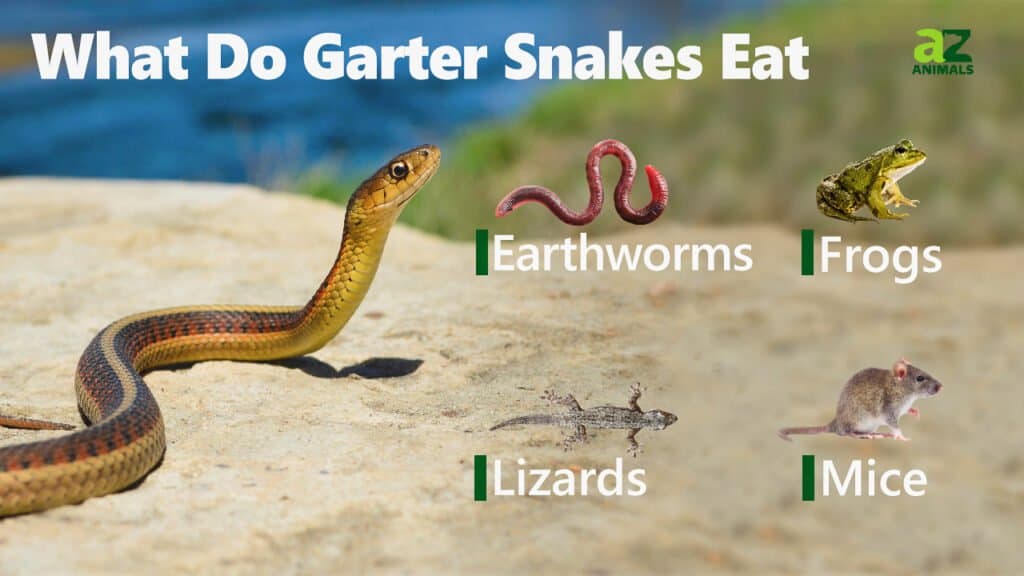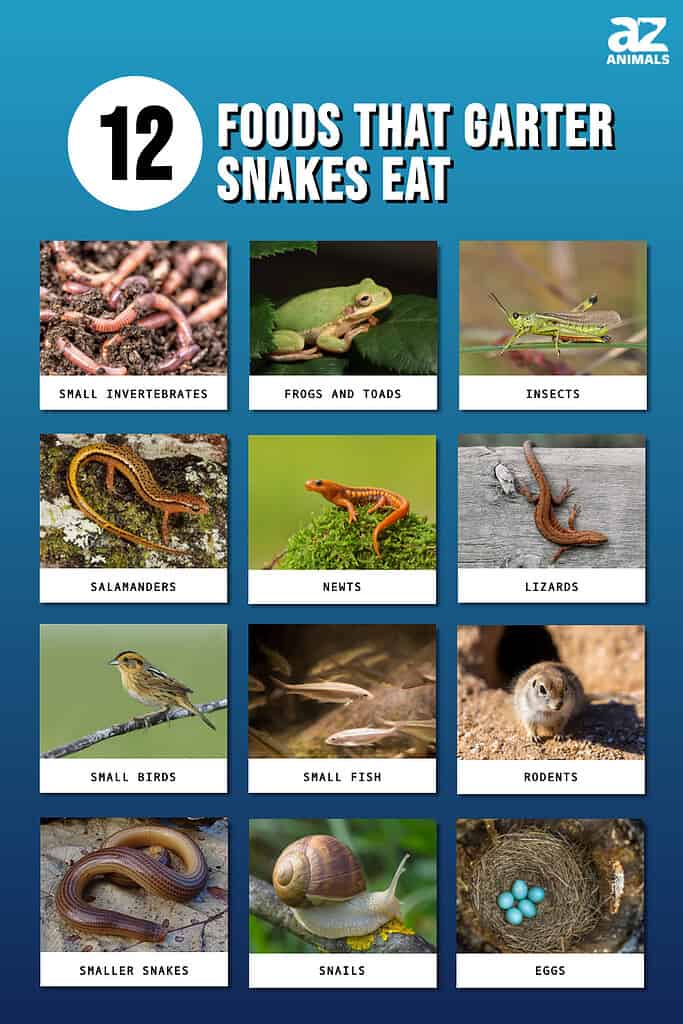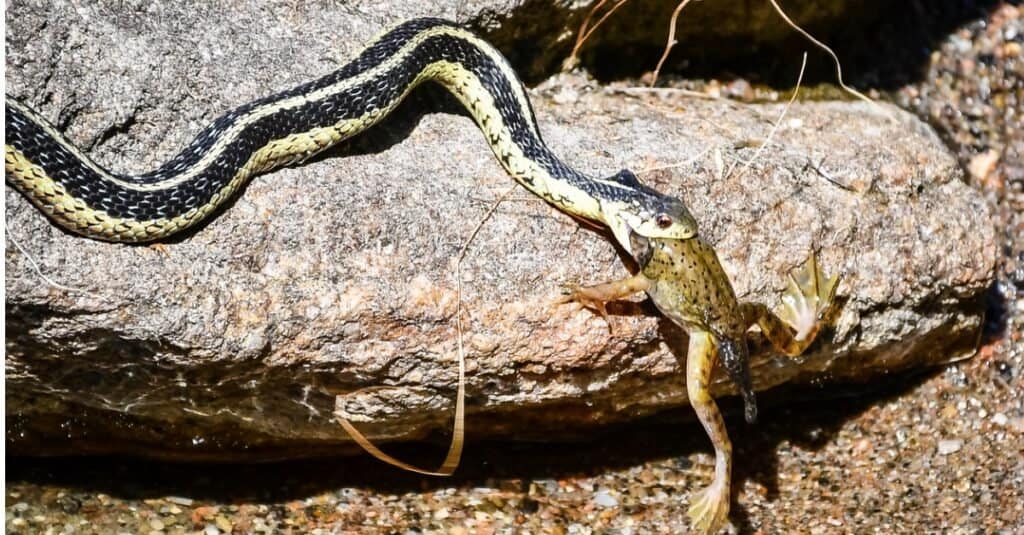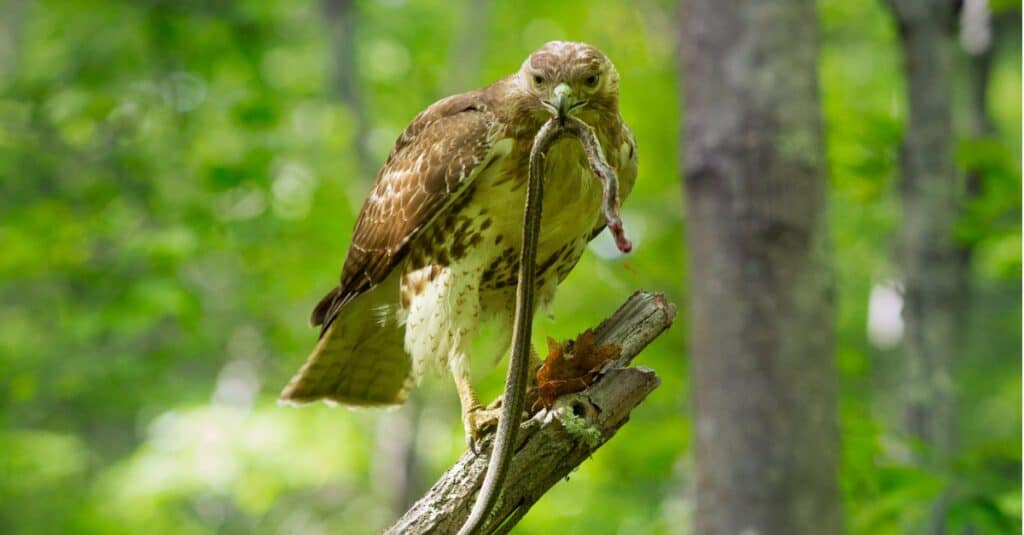Key Points:
- The main staples of a garter snake’s diet are earthworms, frogs, lizards, and mice.
- Garter snakes prefer to hunt small and weak animals due to the fact they lack powerful venom or the ability to constrict their prey.
- These snakes won’t eat dead or decomposing animals — their prey needs to be alive for them to be interested in it.

One of the most common snakes throughout much of North and Central America, the garter snake is a member of the Colubridae family. Colubridae is the largest family of snakes, with roughly 1,700 species. Most Colubrids are either nonvenomous or have very weak venom, so they are considered mostly harmless to humans. So, what do garter snakes eat?
Despite their non-threatening appearance and small size compared to more fierce predators in the Serpentes suborder, garter snakes are still quite skilled hunters who feed on a variety of animals. These little snakes are incredibly useful ecologically by controlling rodent and insect populations, and many gardeners even like to keep a few around in their backyard to keep pests away from their crops.
Let’s take a look at what the average garter snake eats on a daily basis, how they locate and take down their prey, and the various higher-level predator animals they have to look out for whenever they’re searching for their next meal.
What Foods Do Garter Snakes Eat?

Like all snakes, the 30+ unique species of garter snakes are strict carnivores. This means they don’t eat plant matter and subsist solely on meat from other animals.
Because they are one of the smaller varieties of snakes and lack powerful venom or the ability to constrict their prey, they prefer to hunt animals that are small and weak enough to easily ambush and swallow whole.
Garter snakes won’t eat animals that are already dead or decomposing, either! Their prey needs to be alive for them to be interested in it. However, they will occasionally eat eggs from smaller birds and reptiles because they are easy targets and have lots of protein.
Here’s a list of the many kinds of animals garter snakes eat regularly:
- Small invertebrates like earthworms and slugs
- Frogs and toads
- Insects like crickets and grasshoppers
- Salamanders
- Newts
- Lizards
- Birds, particularly smaller species
- Small bony fishes, ex. minnows and guppies
- Rodents like mice, shrews, and chipmunks
- Smaller snakes, especially babies and juveniles
- Snails
- Eggs (from birds, reptiles, or fish)
How Do Garter Snakes Hunt Prey?

A garter snake ambushes a frog.
©iStock.com/Katie Duncan-Burt
Despite their small size, garter snakes are skilled hunters who use their lightning-fast reflexes to ambush their prey. They also have excellent sight and a keen sense of smell. Their sharp senses help them locate and stalk their prey without immediately alerting the prey animal to their presence.
A garter snake’s tongue rapidly darts out of their mouth and flicks at the ground and air, picking up scents and transmitting information about them to their vomeronasal organ (also known as a Jacobson’s organ). This organ is located in the roof of their mouth.
Their vomeronasal organ then interprets the information, alerting the snake to what kind of prey is nearby and how far away they are (as well as locating predator animals nearby, too!).
Once they’ve located their next meal, a garter snake will wait for the perfect moment to strike before swallowing the prey whole. Next, they use the powerful muscles throughout their body to slowly move the animal down their digestive tract.
Interestingly, although garter snakes were long considered to be non-venomous, more recent research has shown that their saliva actually possesses a very weak neurotoxic venom. Although it’s somewhat effective for hunting smaller animals, the venom is mild and non-lethal to humans, especially since garter snakes lack the hollow fangs needed to effectively and reliably deliver it to their prey.
What Animals Eat Garter Snakes?

A red-tailed hawk captures an unfortunate garter snake.
©iStock.com/Holcy
Because they are so small and lack much in the way of defense mechanisms, garter snakes are commonly preyed upon by a number of larger animals, including other snakes!
More specifically, garter snakes have a huge array of mammalian, avian, amphibious, and reptilian predators to look out for while they’re on the hunt for a meal, such as:
- Foxes
- Bears
- Bullfrogs
- Raccoons
- Hawks
- Snapping turtles
- Crows
- Eagles
- Herons
- Owls
- Larger snakes like kingsnakes and coral snakes.
Despite their weakness and small size, garter snakes actually do possess just one somewhat effective defense mechanism. They can emit a foul-smelling secretion from the glands surrounding their cloaca, which helps to deter certain predators!
Garter Snake vs Rattlesnake: Diet

Rattlesnakes eat rodents, amphibians, birds, and many other animals.
©Joe McDonald/Shutterstock.com
Venomous snakes like the rattlesnake have a broader range of animals they can feed on due to their poison-inflicting superpower. Here’s a list of some animals that rattlesnakes eat:
- Frogs
- Toads
- Newts
- Salamanders
- Rodents
- Mice
- Rats
- Hamsters
- Moles
- Rabbits
- Squirrels
- Mongooses
- Birds
- Bird eggs
- Lizards
- Small Crocodiles
- Grasshoppers
- Crickets
- Beetles
- Termites.
Summary of What Garter Snakes Eat
Here’s a recap of the foods that garter snakes commonly consume:
| Number | Food |
|---|---|
| 1 | Small invertebrates (e.g. earthworms, slugs) |
| 2 | Frogs and toads |
| 3 | Insects (e.g. crickets, grasshoppers) |
| 4 | Salamanders |
| 5 | Newts |
| 6 | Lizards |
| 7 | Birds, particularly smaller species |
| 8 | Small bony fishes (e.g. minnows, guppies) |
| 9 | Rodents (e.g. mice, shrews, chipmunks) |
| 10 | Smaller snakes, especially babies and juveniles |
| 11 | Snails |
| 12 | Eggs from birds, reptiles, or fish |
The photo featured at the top of this post is © iStock.com/Katie Duncan-Burt
Discover the "Monster" Snake 5X Bigger than an Anaconda
Every day A-Z Animals sends out some of the most incredible facts in the world from our free newsletter. Want to discover the 10 most beautiful snakes in the world, a "snake island" where you're never more than 3 feet from danger, or a "monster" snake 5X larger than an anaconda? Then sign up right now and you'll start receiving our daily newsletter absolutely free.
Thank you for reading! Have some feedback for us? Contact the AZ Animals editorial team.






